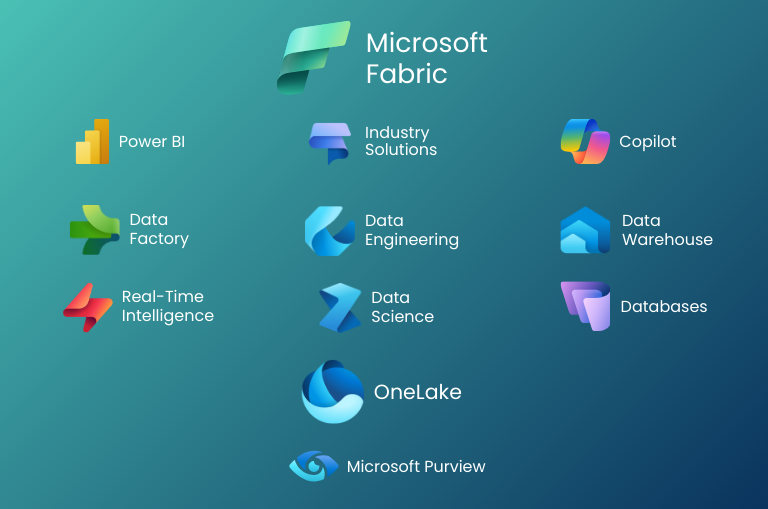Advanced open-source analytical platforms such as KNIME Analytics Platform and the versatile Microsoft Fabric environment provide organizations with holistic capabilities to transform raw data into strategically important business information.
KNIME Analytics Platform vs Microsoft Fabric: Data Platform Comparison
By leveraging their rich analytical features, enterprises can effectively strengthen the process of making key strategic decisions and implement intelligent automation of routine operational processes.
The transformation toward artificial intelligence goes beyond mere implementation of technology – it represents a fundamental shift in the paradigm of thinking and decision-making within the organisation. Data serves as a source of knowledge; people give it context and interpret it, while artificial intelligence supports the discovery of hidden patterns and automates complex operations.
What are modern data platforms?
A modern data platform is a comprehensive solution enabling management of the entire data lifecycle – from acquisition through storage, processing, to analysis and visualisation.
Unlike traditional systems, modern platforms offer scalability, flexibility, and advanced analytical features, often using the cloud as the operating environment, which eliminates the need to manage physical infrastructure.
What is the KNIME Analytics Platform in the open-source model?
KNIME Analytics Platform is a free, open-source data analysis platform created in 2004. It enables visual creation of analytical workflows by connecting modular components without the need for programming.
It integrates tools for machine learning, data mining, data transformation, and visualisation in an intuitive graphical interface.
KNIME is based on a modular node architecture connected into workflows. Each node performs a specific analytical task, and data flows between them sequentially.
The benefits include process transparency, reusability of components, ease of debugging, and visual representation of complex analyses without coding.
A modern data platform in the open-source model is a solution with publicly available source code, allowing the community to develop and customise the tool. It provides transparency, flexibility, and independence from a single vendor. It eliminates licensing costs, allowing organisations to invest in analytical skill development instead of software.
Strengths
KNIME’s strength lies in its open code, transparent operations, and visual interface that enables the creation of advanced analyses without programming and a vast library of ready-to-use components. The platform offers full control over data, a modular architecture that facilitates reusability of solutions, community support, and no licensing costs for the basic version.
Weaknesses
KNIME’s limitations include the need to manage infrastructure independently for team collaboration, lower scalability compared to cloud-based solutions, limited integration with modern generative AI tools, and the lack of a unified environment for the entire data lifecycle. Performance may be an issue with large datasets.
Integrations
KNIME integrates with various tools through dedicated nodes and extensions. It works with programming languages (Python R Java) databases (via JDBC) BI tools big data platforms (Hadoop Spark) and machine learning libraries. It also enables data import/export in various formats and integration with APIs.
AI and Machine Learning
KNIME offers a rich set of machine learning tools without the need for programming. It allows the creation of predictive classification and clustering models, time series analysis, and integration with AI libraries. The visual interface enables users to build and validate ML models without advanced programming skills.
Pricing model
KNIME Analytics Platform is available as free open-source software. Commercial extensions include KNIME Hub plans: Personal (free), Team, Basic, Standard, and Enterprise, with varying levels of collaboration and automation functionalities. Educational and research organisations can receive significant discounts or free licenses for commercial extensions.
When to choose KNIME Analytics Platform?
Choose KNIME if you value open-source software, want to avoid dependency on a single vendor, have a limited IT budget, need transparent and modifiable analytical processes, your team prefers visual analysis creation without coding, or you operate in an academic/research environment requiring full control over methodology.
What is Microsoft Fabric
Microsoft Fabric is a comprehensive data and analytics platform combining various tools in one environment. Based on a SaaS architecture, it integrates components such as Data Factory, Data Engineering, Data Warehouse, and Power BI.
Its central element is OneLake – a unified data repository. Fabric offers built-in AI features, including Microsoft Copilot, enabling task automation and generation of intelligent insights.

Microsoft Fabric is based on a SaaS architecture with OneLake as its central element, eliminating data silos. The platform combines all data workloads from data engineering and warehousing to real-time analytics.
Benefits include centralised data management, seamless integration with the Microsoft ecosystem, built-in AI features, and the medallion architecture (bronze-silver-gold) supporting data processing from raw to advanced analysis.
See the business guide on Microsoft Fabric
Strengths
Microsoft Fabric stands out with the comprehensive integration of all aspects of data analytics in one platform. A key advantage is OneLake – a unified repository eliminating data silos. Fabric offers a wide range of analytical tools tailored to various organisational roles. Native integration with the Microsoft ecosystem (Power BI, Azure, Microsoft 365) ensures smooth workflows. Built-in AI features, including Microsoft Copilot, automate tasks and deliver intelligent insights. Fabric also enables comprehensive data management with access control and regulatory compliance.
Weaknesses and limitations
Despite its comprehensiveness, Microsoft Fabric has limitations. The platform is tightly coupled with the Microsoft ecosystem, which can hinder integration with solutions from other providers. Fabric is a relatively new product, so its functionalities are less mature compared to specialised tools. Multi-cloud flexibility is mainly limited to Azure. The capacity model may be less flexible for organisations with variable computational needs. Additionally, the platform’s complexity may extend the learning curve for new users.
Integrations
Microsoft Fabric offers native integration with the entire Microsoft ecosystem, including Microsoft 365, Microsoft Azure, Microsoft Copilot Studio, and Microsoft Power Platform. It also has numerous connectors to external systems, including Snowflake, Google BigQuery, MongoDB, and AWS S3. With Data Factory, Fabric can retrieve data from various structured and unstructured sources. Integration with Power BI provides advanced visualisation capabilities, and connection to Microsoft Azure AI Foundry enables the use of advanced artificial intelligence features.
AI and Machine Learning
Microsoft Fabric offers advanced AI capabilities through integration with Azure Machine Learning in Microsoft Azure AI Foundry and Microsoft 365 Copilot. The platform enables the creation, deployment, and management of ML models within a unified environment without switching between tools. AI features are built into the entire data lifecycle from engineering to business analysis. Fabric automates routine tasks, creates fast reports, and builds auto-models, making it a good choice for companies seeking integrated AI experiences.
Pricing model
Microsoft Fabric offers two main pricing models: Pay-as-you-go (flexible with no commitments) and Reserved (with up to 40% savings with annual reservation). Costs depend on two main factors: compute and storage. A single compute capacity can support all features simultaneously and be shared across multiple projects. Fabric also offers three user license types: Free, Pro, and Premium per user.
See the guide on Microsoft Fabric licensing and pricing
When to choose the Microsoft Fabric data platform?
Microsoft Fabric will be the optimal choice for organisations already using the Microsoft ecosystem. It is suitable for companies seeking a comprehensive solution covering the entire data lifecycle – from acquisition to visualisation. It is ideal for enterprises needing integration of various teams (data engineers, analysts, and data scientists) on one platform.
Fabric is also suitable for organisations looking to leverage advanced AI features without building complex infrastructure using built-in tools supported by Microsoft Copilot.
What is the difference between KNIME Analytics Platform and Microsoft Fabric?
KNIME Analytics Platform and Microsoft Fabric fundamentally differ in approach and business model. KNIME is an open-source desktop analytical tool with extensibility focused on modular workflows and available without licensing fees. Microsoft Fabric is a comprehensive SaaS cloud platform integrated with the Microsoft product ecosystem.
KNIME offers greater independence and transparency but requires its infrastructure for team collaboration. Fabric provides a ready, fully managed cloud environment with integrated tools and scalable infrastructure.
Small organisations and educational institutions often choose KNIME, while Fabric is targeted at medium and large enterprises already using Microsoft solutions. KNIME is community-driven. Fabric is supported by corporate integration and support.
The choice between them depends on existing infrastructure, specific analytical needs, and integration preferences of the organisation.
Which system to choose for the company?
Small company
For a small company, the key selection factor is ease of implementation and minimisation of administrative costs.
For small companies, the KNIME Analytics Platform is often a better choice due to its no-licensing costs, low infrastructure requirements, and the ability to create analyses independently. It provides the basic analytical features needed in a small business without the need to invest in an extensive cloud environment.
Medium company
A medium-sized company should base the choice on existing IT infrastructure and specific analytical needs.
A medium-sized company should make a decision based on its existing IT infrastructure. If it uses Microsoft solutions, Fabric may provide better integration and scalability. Companies valuing independence, transparency of analytical processes, and cost control may prefer KNIME, especially if they have an analytical team.
Large company
Large enterprises should make their choice based on the IT strategy, existing investments, and long-term data management vision.
Large companies often choose Microsoft Fabric due to its comprehensive scalability, advanced security features, and integration with the Microsoft ecosystem. Fabric enables enterprise-scale data management and advanced analytics. KNIME can be a complementary tool for teams requiring algorithm transparency and analytical flexibility.
Summary
The choice between KNIME Analytics Platform and Microsoft Fabric depends on specific business needs, existing IT infrastructure, and the organisation’s budget.
KNIME offers a free, transparent solution with a visual interface ideal for small and medium-sized businesses and educational environments that value control over analytical processes.
Implementing Microsoft Fabric will be a better choice for organisations integrated with the Microsoft ecosystem, valuing ease of deployment, a unified environment, and ease of use without the need to manage infrastructure.
An optimal approach may be a hybrid use of both platforms, where KNIME serves for exploratory data analysis and prototyping, and Fabric provides scalable infrastructure for production analytical solutions, allowing maximum benefit from both systems.

Microsoft AI Certified Consultant / ARP Ideas Growth Manager
An experienced consultant and AI enthusiast specializing in digital transformation and Microsoft cloud solutions. For many years, he has been passionately combining the world of business with digital experience design, focusing on business process automation in key areas such as marketing, sales, customer service, digital workplace, HR, and internal communication.
